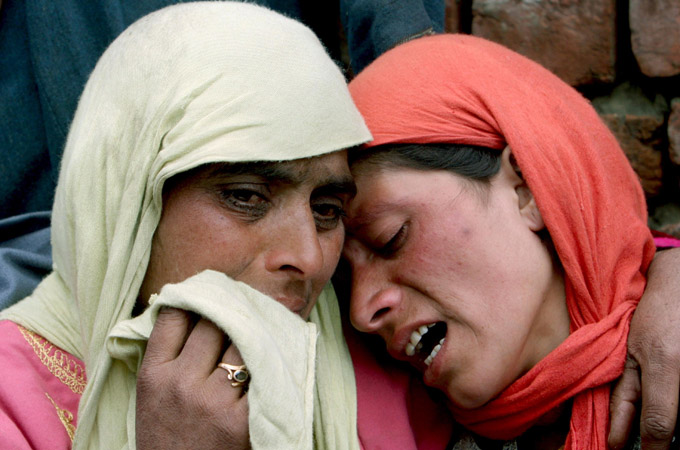Glimpses of the situation in Kashmir through the eyes of women
By Neeraj Mahajan
Without any doubt, men take the most
active part and bear the brunt of any conflict situation but imagine the plight of the women – they leave behind?
What about the struggles of these largely uneducated women, without any prior
work experience who have to overnight start earning to bring up the children? Besides
mourning their dead or missing husbands or sons and struggling to rebuild their
homes and lives, these women have to cope with mental trauma and economic
hardships.
It would not be wrong to say that these
women, irrespective of their loyalty are caught between two guns - that of
terrorists and troops and pay the heaviest price ranging from rape or molestation
to torture or losing their loved ones.
While
for some men – death may be the end of life…but for the women they leave
behind….its the life after the death that’s most torturous. Why
Kashmir—a single woman… that too a good looking, young widow without any male
member to protect her may be subjected to varying forms of sexual violence from
teasing, passing of comments, obscene gestures and molestation—anywhere in
India ?
Even if just for argument sake, we
ignore the external threats, most of these Kashmiri
women are most vulnerable not outside, but inside their own homes. Without
even stepping out of their homes they have to face a lot from the suspicion of
their own families to so called distant relative who suddenly crop up from the
blue to get their ‘share’ in the property or compensation. Without an earning
member in the family, most of these women have no option but to go out and work,
but the moment they step out of the home the family members are the first to
brand them as women of 'bad character'. This
pain is not something which is easy to digest, more so when it gets added to the
stigma of widowhood – a largely Hindu phenomenon, which has come to haunt the Muslim
women as well, in Kashmir . As the levels of domestic violence has gone up
sharply in the state in the last decade or so, the women of Kashmir-- Muslim,
Hindu, Sikh and Ladakhi, finding it extremely difficult to decide who is a
friend or foe.
Today, a large numbers of women in
Kashmir can be identified as 'half widows' (women whose husbands are assumed
dead simply because there is no proof to show where they actually are), widows,
mothers who have lost their sons, or those whose daughters have been raped,
young women who dare not step out of the house, women who have been pushed out
of employment by the fear and uncertainty created by conflict, and those who
are suffering from medical and psychological conditions related to emotional
stress and trauma.
Tears roll down her
cheeks as thirty- eight year old Gulshan Ara, a widow from Trehgam in Kupwara
district narrates the experiences she had to undergo after her husbands death
in 1991. Hers is a story of poverty, pain and hunger—with six children and
absolutely nothing to feed them and no relative willing to support the family.
As a result Gulshan was forced to do menial jobs in the neighboring houses but even
then could not make a sustainable earning. There were
times when she also worked as a casual laborer without even getting double
figure amount at the end of the day and as such she and her six children had to
go to bed with a belly full of water
just to satisfy the hunger.
Faced with the option of survival and
its economic consequences, remarriage is the only option left for most
widows…But that too has its side effects as there are several difficult
decisions to make regarding upkeep of children and transfer of property. The
magnitude of the problem is that at least 25,000 women have been widowed in
Kashmir since 1989; this is in addition to thousands of others whose husbands
have become disabled or are leading lives as fugitives – from the security
forces as active militants or from the militants as former militants.
Well
that is as far as the negative side of the story goes. But that itself is the
in-complete picture and a half reality about Kashmir.
The fact is that women themselves are
instinctive harbingers of change and natural peace keepers. As such the women
of Kashmir are no different.
The positive side of the story is that after nearly two decades of
militancy, the average Kashmiris have got fed up with the cult of violence and
hatred in their backyard. And the greatest agents of changes have been the
women- mothers, daughters, wives and widows who have acted as a catalyst in the
entire process.
Even UPA Chairperson Sonia Gandhi, was
all praise for the women of Kashmir as a
symbol of resistance against terror. Addressing a gathering of nearly 5,000
women at Women's Empowerment Conference in Kashmir ,
"the women have always bore the brunt of any disaster, whether natural,
social or political”, she said. “Education
and opportunity are the keys to women's empowerment” she added.


We are a group of volunteers and opening a new scheme in our community.
ReplyDeleteYour web site provided us with valuable information to work on.
You have done an impressive job and our whole community will be grateful to you.
Here is my web site :: HardKnight